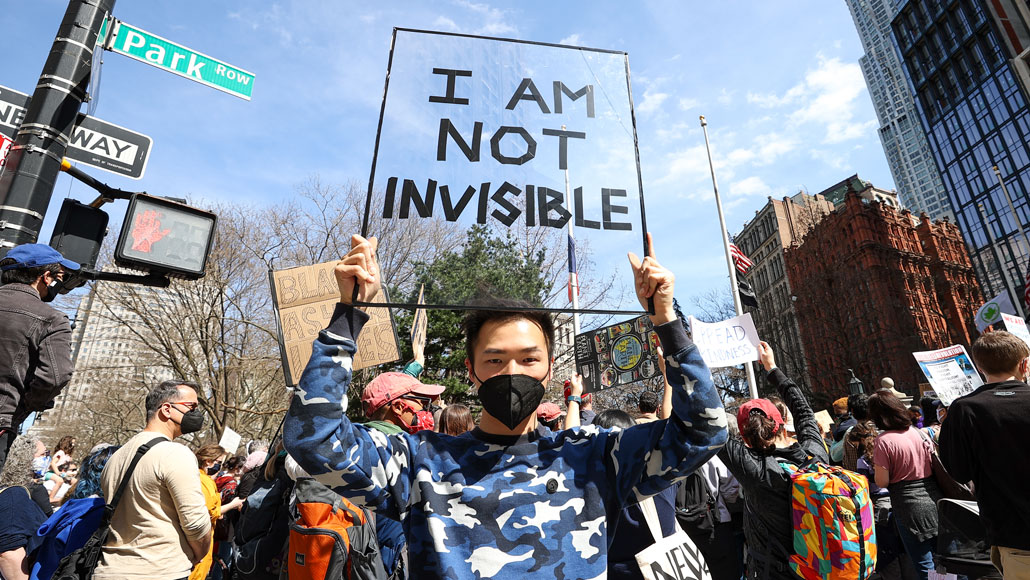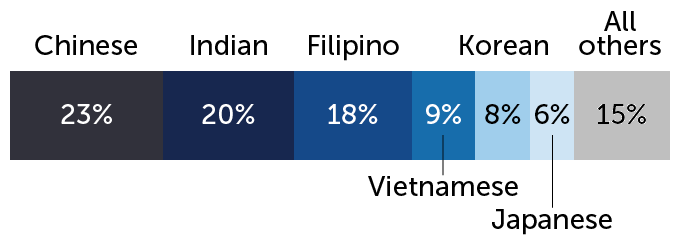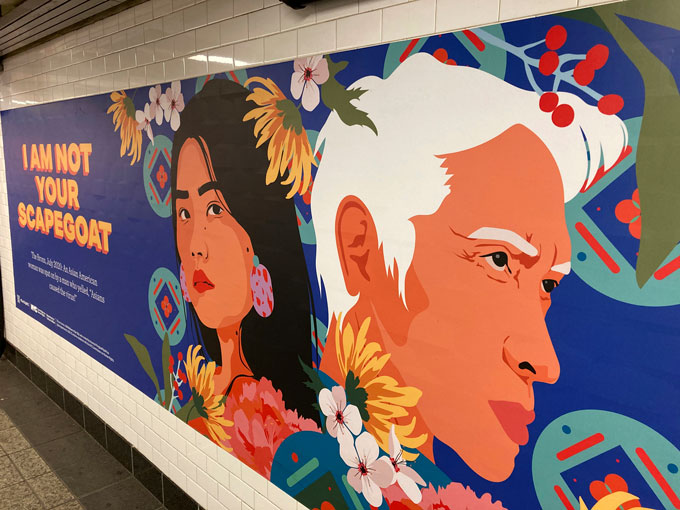How science overlooks Asian Americans
The pandemic put Asian Americans in a spotlight — and revealed how little is known about them

Protesters gathered in New York City in March in the wake of the Atlanta spa shootings to draw attention to escalating hate directed at Asian Americans. Too often, Asian Americans are overlooked or treated as a monolithic group in research studies, rendering them invisible, researchers argue.
Tayfun Coskun/Anadolu Agency via Getty Images
For years, sociologist ChangHwan Kim has sought to characterize the lives and experiences of Asian Americans. Gatekeepers in the research community, though, have often scoffed at his focus on a demographic group that looks like the picture of success in terms of education, earnings, health and other variables (SN: 4/14/21).
“In my experience, if I have a study with only Asian Americans, journals are reluctant to publish that work,” says Kim, of the University of Kansas in Lawrence.
An apparent lack of interest in studying Asian Americans isn’t limited to sociology; it even appears in medical research. At about 23 million people, Asian Americans represent about 7 percent of the U.S. population and are the fastest-growing demographic group in the country. Yet just 0.17 percent of the National Institutes of Health’s roughly $451 billion research funding between 1992 and 2018 went to clinical studies that included a focus on Asian Americans, researchers reported in 2019 in JAMA Network Open.
Over the last year, politicians’ use of racial epithets, such as “China virus” and “kung flu”, to refer to COVID-19, alongside a surge in violence against Asian Americans, has thrust this population into the media spotlight. This attention is “a new phenomenon,” Kim says. That media gaze has showcased just how little is known about Asian Americans and, consequently, how to best meet the population’s needs.

Asian Americans’ invisibility in public and scientific discourse stems from the majority-minority paradigm, Kim says. This sociological paradigm frames white Americans, the majority, as better off than minority groups across several metrics, including educational outcomes, wages and family stability. So studies of minorities often focus on issues related to marginalization and inequality. Asian Americans do not appear to fit the paradigm.
“Minorities are doing worse than whites. That’s what people want to talk about,” Kim says. “Studies on Asian Americans make things complicated.”
Nuanced success
Because of their apparent success, Asian Americans are often excluded from research, lumped together with white people or placed in the catchall category “other.”
But studying success is itself important, says sociologist Arthur Sakamoto of Texas A&M University in College Station. For instance, researchers study both struggling and successful white Americans to understand the full range of outcomes within the group, he says. Yet, with minority groups, researchers largely focus on those who are struggling, thereby excluding Asian Americans. “If you really want to understand the ultimate nature of social problems, you also have to study the contrast,” Sakamoto says. “You can’t just study one end of the distribution.”
Moreover, Asian Americans do face challenges. For instance, they are less likely to utilize mental health services than other demographic groups, and not simply because they have fewer mental health issues (SN: 1/22/21). In the January 2020 Psychiatric Services researchers reported that, among a U.S. sample of 10,494 white people and 451 Asian Americans diagnosed with major depressive disorder, 70 percent of the white people received mental health treatment compared with just 35.3 percent of the Asian Americans.
And though their education levels and earnings are on par or even higher than white Americans, Asian Americans are underrepresented in managerial and supervisory positions. Researchers refer to this as a “bamboo ceiling.”
Even when Asian Americans are studied, researchers rarely break down this extremely heterogeneous group into individual populations. Members hail from at least 19 countries, each with different cultures and languages, and no one population dominates. Thus, treating Asian Americans as a monolithic group can hide struggling subgroups. The overall Asian American poverty rate is 10 percent, for example, but jumps to 25 percent for Mongolian and Burmese populations, according to an April report from the nonpartisan Pew Research Center.
Widespread origins
Caption: While the bulk of Asian Americans come from these six countries, altogether they hail from at least 19 countries. The group’s members immigrated at different times and for different reasons, with some fleeing persecution and others pursuing doctorates. Such wide intragroup variation means that data on Asian Americans should be broken down by ethnicity, generational status, gender and class to understand their experiences and needs, researchers argue. But sample sizes in studies are often too small to disaggregate.
Asian Americans, by ethnicity


Understanding this group and its complexities is becoming increasingly important as the population grows, Kim says. Asian Americans are projected to surpass Hispanic people as the largest immigrant group by 2055, according to Pew. By then, Asian Americans are expected to comprise 36 percent of all U.S. immigrants and Hispanic people 34 percent.
Gaps in the data
The datasets researchers use to study U.S. demographic groups reflect this long-standing disinterest in studying Asian Americans, Kim says. Few surveys rope in enough Asian Americans to study subgroups within the category in detail. That’s true he says even of the U.S. Census Bureau’s annual surveys, which provide snapshots of demographic and labor trends.
Meanwhile, few popular longitudinal surveys that follow people across long stretches of time, such as the National Longitudinal Surveys and Panel Study of Income Dynamics, include enough Asian American people to even study them as a bloc. “We cannot study how Asian Americans move across their lives or how Asian Americans move from the parents’ generation to the second generation,” Kim says.
Community psychologist Nellie Tran ran into that problem several years ago. As a graduate student, she wanted to understand the educational outcomes of U.S.-born Asian Americans and scoured the scientific literature. “I only came up with 45 articles in history,” says Tran, now at San Diego State University.
Most of those articles relied on a single dataset, the National Educational Longitudinal Study of 1988, which ran from 1988 to 2000 and followed individuals from eighth grade to young adulthood. Sociologists “were studying many different questions off one group of students,” Tran says. That group wasn’t even relevant to Tran’s work, as the Asian Americans in the survey were predominantly foreign-born.
Sign up for our newsletter
We summarize the week's scientific breakthroughs every Thursday.
Kim and other researchers have developed work-arounds to overcome those gaps. Studying well-educated Asian Americans is feasible, for instance, thanks to the National Survey of College Graduates. That survey, conducted by the Census Bureau, takes place every two to three years and tracks outcomes for U.S. bachelor’s degree holders. Because of their strong presence in higher education and white-collar jobs, Asian Americans are well-represented in this survey. The survey also includes data on where first-generation Asian Americans originated. “That means you can actually divide Asian Americans by ethnic group. So for well-educated Asian Americans, we have a dataset,” Kim says.
Kim’s research using that data has revealed inequalities even among this select group. College-educated Asian American men born in the United States earn 8 percent less than white men with the same level of education and college major, Kim and Sakamoto reported in 2010 in American Sociological Review. Similarly, Asian American women are less likely to reach managerial positions than white women with the same qualifications, Kim noted in 2014 in Social Forces. For both men and women, these disadvantages are evident across most Asian ethnic groups.
Similar datasets do not exist for less-educated Asian Americans. For example, six of the eight victims in the Atlanta mass shooting in March were Asian American women and probably blue-collar workers, Kim says. Blue-collar Asian Americans are the most invisible members of an already invisible group. “We need to know who are they, what they need,” Kim says. For instance, little is known about what access such workers have to relevant social programs or if those programs are culturally appropriate.
Recently, Kim and colleagues zoomed in on employment changes brought on by the pandemic. He used short-term census data and looked for changes in individual employment from January to August 2020. When Kim dove into the data, he says he was startled to find that Asian Americans lacking a bachelor’s degree were more likely to have lost their job during the initial lockdown in April and May 2020 than any other demographic group. That finding appeared in the February Research in Social Stratification and Mobility. Kim could not break the data down further to see which Asian American ethnic groups suffered the most.

Overcoming publication bias
Absent a targeted effort to study Asian Americans, progress in understanding this demographic group will remain limited, Kim says.
Right now, when he submits studies focused on Asian Americans, he includes a lengthy explanation of the need for such work. He ropes in those statistics showing how fast the Asian American population is growing. And he argues that Asian Americans’ experiences can help elucidate how immigrants assimilate — or not — in the United States. He is particularly interested in understanding how that assimilation process differs by socioeconomic status, gender and country of birth. For instance, how does the life trajectory of a blue-collar Asian immigrant differ from that of a U.S.-born, white-collar third-generation Asian American?
Asian Americans, with all their successes and struggles, merit their own analysis, Kim says. “Look at all the other studies that focus on African Americans only, Hispanics only, white Americans only. Why is studying Asian Americans only not legitimate?” he asks. “Asian Americans are Americans. We need to understand them.”







